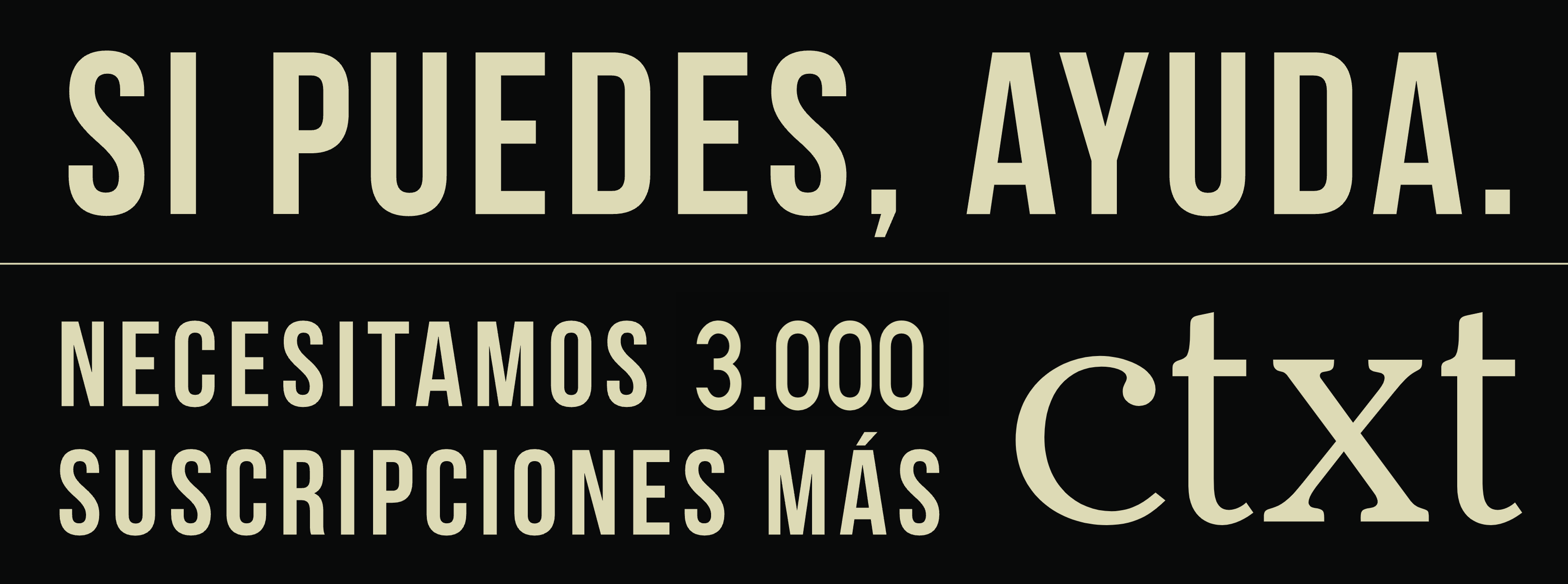
En CTXT podemos mantener nuestra radical independencia gracias a que las suscripciones suponen el 70% de los ingresos. No aceptamos “noticias” patrocinadas y apenas tenemos publicidad. Si puedes apoyarnos desde 3 euros mensuales, suscribete aquí
Nace El Dobladillo, el papel mensual interactivo y ecológico de CTXT ¿Quieres recibirlo en casa? ¡Suscríbete!
|
|
Oferta lanzamiento (50 euros al año, envío España) |
Igual que al inicio de la primera revolución industrial, tenemos miedo. A lo largo de los últimos doscientos años nos habíamos permitido autoengañarnos y –a pesar de la sucesiva irrupción de horrores bélico-políticos que interrumpieron el camino– sentirnos más o menos capaces de imaginar un destino benévolo para nuestra especie. Ahora la realidad se presenta de nuevo inaprehensible y recurrimos otra vez a las sombras, al elogio de la locura, al monstruo que muestra aquello que no sabemos cómo comenzar a exponer de otra manera. Como explica Francisco Jota-Pérez en su espléndido Homo Tenuis, vivimos en tiempos hipersticiosos: “Los zarcillos de estas criaturas hipersticiosas, hipotéticamente situadas en el fin de la Historia, más allá del fin de la existencia tras haberla devorado, se desenroscan hacia atrás en el tiempo y llegan hasta nuestro presente, manifestándose como una oscura voluntad de progreso que despedaza políticas culturales, elimina tradiciones y disuelve subjetividades” (p. 28).
Es fácil desestimar la proliferación del horror literario y filosófico como si se tratase de una tendencia juvenil pasajera o parte del “proceso de exterminio por entretenimiento constante”, pero lo cierto es que la estética del horror siempre ha estado ahí, puntualiza Álvaro Arbonés. La filosofía y la literatura “siempre han celebrado, nunca ocultado, sus conclusiones más escabrosas”. Como durante el Romanticismo, las metáforas más poderosas de la ficción actual emanan de cierta angustia metafísica que, aunque inspira numerosas obras banales (como si la literatura supuestamente ‘adulta’ y estereotípicamente ‘realista’ no hubiese sido también asfixiada por la banalidad…), alimenta algunas de las más agudas intuiciones acerca de nuestro tiempo. No podemos continuar pensando en la estética del horror como una característica exclusiva del género fantástico, pues ninguna obra que en nuestros días se pretenda realista puede ya ignorar que el horror se ha convertido en un elemento esencial de la cultura contemporánea. Como demuestra la reciente novela Amygdalatropolis, de B.R. Yaeger, el ciberpunk del siglo XXI es realista, sin la mínima concesión a la extrapolación tecnodistópica: basta un poco de Kafka y Burroughs, una habitación cerrada, y una conexión a internet.
La “verdad” se construye a partir de mentiras, y las mentiras están ahí fuera para ayudarnos a desarrollar un nihilismo práctico y material
Las tinieblas comienzan a expandirse en el mercado editorial español como una refrescante conspiración –extendiendo a la edición una actitud previamente manifestada en proyectos de “autoría filoconspiratoria” como el del Colectivo Juan de Madre–, y bienvenidas sean. La Felguera, por ejemplo, se describe a sí misma como “una editorial que, bajo la apariencia de una sociedad secreta, se dedica a revelar los mejores secretos de su tiempo”, principio por el que se rigen no sólo su selección de títulos y autores, sino también sus métodos de promoción y venta. Otras nuevas editoriales independientes como Gasmask (responsable del mencionado libro de Francisco Jota-Pérez), Materia Oscura (que ha traducido a Eugene Thacker y acaba de publicar la maravillosa Cyclonopedia, del filósofo iraní Reza Negarestani), Orciny Press, Excodra, o la más reciente Antipersona, se empeñan en reeditar y descubrir el viejo y nuevo horror que se oculta bajo la fina piel de un universo que creíamos nuestro, y cuya “humanidad” hemos dado por supuesta durante demasiado tiempo. La “verdad” se construye a partir de mentiras, y las mentiras están ahí fuera para ayudarnos a desarrollar un nihilismo práctico y material en la línea de Sade y Bataille. “El capitalismo es extravagante, y el arte, para contrarrestarlo, debe responder con su propia mayor extravagancia”, escribe James Pate en Flowers Among The Carrion. Y, en cualquier caso, como nos recuerda Boris Groys, “el objetivo del arte es empeorar las cosas”.
Nace El Dobladillo, el papel mensual interactivo y ecológico de CTXT ¿Quieres recibirlo en casa? ¡Suscríbete!
|
Este artículo es exclusivo para las personas suscritas a CTXT. Puedes iniciar sesión aquí o suscribirte aquí
Autor > Germán Sierra
Suscríbete a CTXT
Orgullosas
Gracias a tu suscripción podemos ejercer un periodismo público y en libertad. Artículos relacionados >Efectos parciales
Carlos Acevedo
Laura Freixas, Mercedes Cebrián, Natalia Carrero
El Ministerio
Elvira Navarro, Sara Mesa, Luna Miguel
El Ministerio
El canon como justicia poética
Guillem Martínez
Tres parábolas sobre el canon
Texto: Gonzalo Torné / Ilustraciones: Carlos Brayda
11 comentario(s)¿Quieres decir algo? + Déjanos un comentario
Deja un comentario
Los comentarios solo están habilitados para las personas suscritas a CTXT. Puedes suscribirte aquí
|









